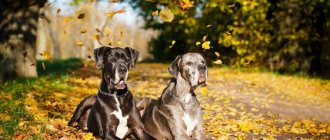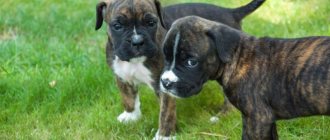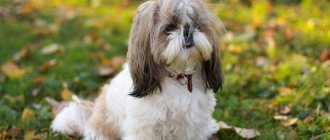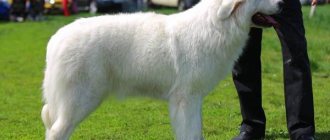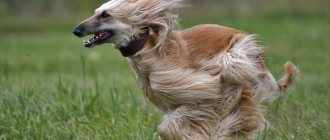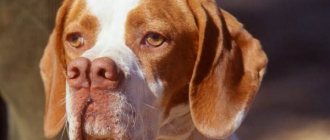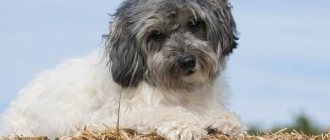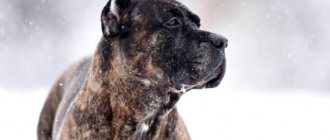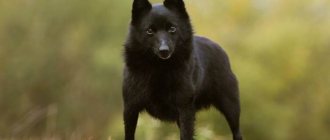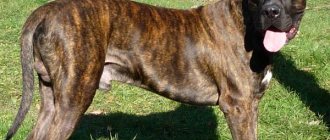Great Dane in the photo
Everyone knows that man's best friend is a dog. The Great Dane is proof of this saying: loyal, kind, strong, level-headed and courageous. There are 6 types of Great Danes, all of them come from different countries, and therefore are endowed with an original appearance and unique working qualities.
Description and features
When a Great Dane dog appears on the street, the eyes of all surrounding people and animals turn to it. This is not surprising, because with all her appearance she inspires power and strength. However, she is not at all aggressive by nature. This is the main feature of the representative of the breed - the discrepancy between the character and appearance.
Let's delve a little into the history of the breed. It is believed that the first ancestors of Great Danes came from Tibet. It was there that most large dog breeds were selected. From the center of the Asian continent, animals quickly spread to other regions of the world, rapidly gaining popularity.
In ancient times, large dogs, including the one in question, were used for many “jobs”: protecting the territory, fighting, hunting big game, etc. It is worth noting that due to its peaceful nature, the Great Dane did not cope well with protection. He greeted each guest cordially, without fear that he might be an intruder. Except that his appearance can scare you away.
Why did the dog get the name “German”? It's simple. There have always been more huge guys in Germany than in other countries of the world. For some reason, the Germans fell in love with these charming animals more than others.
The functionality of a modern representative of the breed is just as universal as that of an old one. However, previously it was often used as a rider, but today it is extremely rare. But in vain. In terms of strength, the beast is very powerful. He is resilient and very brave.
Good nature does not prevent the Great Dane from being a reliable bodyguard. But in order to develop responsibility and observation in such a dog, it is recommended to raise it correctly. Fear is completely unknown to her. This is a desperate creature that will stop at nothing if its owner is in danger.
In addition, Great Danes are wonderful companions. They can faithfully wait for the owner from the store or go for a walk with him. They especially love sports. For example, you can invite such a pet to accompany you on a jog or take him with you on a bike ride.
It's hard to believe that these animals are incredibly affectionate and vulnerable. A rude word spoken to them will probably cause them to plunge into depression for several days. Therefore, when interacting with these funny four-legged pets, be kind and forgiving.
Breed standard
The Great Dane breed is large and massive. Having seen her representative, it is difficult to take your fascinated gaze away from him. Male Great Danes are significantly taller than females. Their average height at the withers is 80 cm, and at the back - 73 cm. Such a creature weighs from 65 to 75 kg.
The dog's physique is harmonious and proportional. Her back is powerful and slightly wide. The neck forms an acute angle with it. There are skin folds on it, especially when the dog straightens up. The lower back is well defined. There is a bulge in its area. The sternum is massive and wide. The dog's tail is thin, but thickened at the base. Has a high seating position.
When at rest, it is lowered down. But when the animal is excited, its tail actively rotates in different directions. The dog's legs are long, set parallel to each other. Equipped with strong muscles. The knee joints are especially well defined. Thanks to this, the animal moves springily, without sudden jerks.
The dog's head is large. The frontal curve is well defined. There are folds of skin above the eyes, which makes the dog appear to have bushy eyebrows. The nose is wide and darkly pigmented. The Great Dane has an excellent bite, but the lower jaw moves slightly forward. This causes his second lip to droop downward.
According to the standard, it should be black. The animal's teeth are snow-white and strong. His jaw is incredibly powerful. The eye sockets fit very tightly to the eyelids. The Great Dane in the photo is shown as interested, good-natured and affectionate. He has a pretty smart look.
It is important that the dog's skin fits tightly to the skeleton. Otherwise, she will not be considered a purebred. Her skin folds should only be on her neck. This animal has a very smooth coat with no undercoat.
Important! After looking at photos of Great Danes, you might think that they are classified into 2 types. The main difference is the shape and size of the ears. But no. In fact, some owners crop their pets' ears due to changes made to the breed standard (1993). This part of the body should not break. If the ears of such a dog are not cropped, they will hang down, covering the sides of the head.
Argentine white
The only breed from Argentina that is officially recognized by the FCI. This is one of the most beautiful mastiffs - ideally built, stately, with smooth snow-white hair, proud posture. The dogs were created by Antonio Martinez in the 1920s, based on the Cordoba fighting dog. Also participating in the selection were:
- Great Danes;
- Pyrenean dogs;
- Bull Terriers;
- Bulldogs;
- Irish Wolfhound;
- English Pointer.
Each of the breeds gave the Argentine new irreplaceable qualities: strength, agility, large size, white color, good scent, power and speed.
Dog was bred as a hunting dog. It was used in a pack of hounds to bait pumas and other large animals. For such a purpose, only the most hardy individuals were selected, because the prey had to not only be caught up, but also defeated.
Externally, the Argentinean is large, heavy, grows up to 70 cm at the withers and weighs up to 50 kg. He has a strong, balanced rectangular body with prominent muscles, a long neck, a medium-sized dry head with small eyes. The coat is short, only white color is allowed.
Now dogs are used as guard dogs. They do an excellent job of protecting humans. Animals have developed intelligence, so they learn quickly and remember commands. But they require special education and professional training. In the family, Dogs behave calmly, not aggressively, respect their owners and children, and even love fun games. The average cost of the breed is 20,000 rubles.
Colors
There are a large number of dog coat color options. But for exhibition animals only 5 options are allowed:
- Pure black. There are no spots on the dog's body. Its dark fur has a beautiful natural shine. Small light spots on the neck are acceptable (only in females).
- Golden. Very beautiful coat color. Also shiny. There is short dark hair on the face and ears.
- Brindle. The main body shade is yellow or sand. Multi-colored stripes of different lengths and thicknesses are also visible. There is no shine.
- Black and white. The dominant color is white. Dark spots have different diameters. Most of them are on the face and back.
- Blue. Beautiful light gray color. There are no spots on the dog's body. It has a natural shine.
The Great Dane's fur is very short, and on any part of its body.
Brazilian
The Dogo Brasileiro is better known as the Fila Brasileiro. This is a large representative of the Molosser, reaching 60-75 cm at the withers, and in weight - from 40 to 90 kg. The exact origin of dogs is unknown, but there is information that they were used as hunters, shepherds, watchmen, and chasers of slaves. Today, with proper training and timely socialization, Fila Brasileiros grow into excellent companion dogs and family pets.
In appearance, “Brazilians” are somewhat reminiscent of Dogo Argentinos. They are strong, muscular, massive. Their head is large, but its size is proportional to the body. The muzzle is long. The ears are not set high, long and drooping. The eyes are in the shape of tonsils or triangles. Limbs parallel, straight.
The coat comes in short and medium length. It is dense, hard and shiny. The most common colors are black, white, and brown. Various variations are possible.
By temperament, these dogs are friendly, loyal, courageous, decisive, vigilant, and balanced. They are wary of strangers, tolerant of children.
The average life expectancy is 12-13 years. Prices for puppies start at $400.
Character
These are very affectionate and devoted pets to their owner. They quickly get used to the people around them and strive to spend as much time as possible with them. The Great Dane loves to sit or lie next to his beloved owner and simply loves when he pets him. Yes, it is not easy to earn the respect of such a pet, but he will like it, on the contrary.
These are very good-natured creatures. They are almost completely devoid of malice. The aggression of such a dog can only be provoked by an attack on its owner. Other times he will be patient and forgiving. He allows even the little ones to do any pranks with him.
The dog will not get angry even if a child pulls its ear painfully. She would never harm a member of her pack, especially a human. In this situation, he will most likely whine and try to gently push the baby away with his paw. In general, he gets along great with children! Can look after them, bring toys and even comfort them.
The Great Dane is an ideal family dog. She is not angry, sociable and very cheerful. Loves noisy fun, especially with balls. Loves to bring objects to the owner that he will throw forward. They tolerate loneliness extremely poorly, as they love to be the center of attention. They suffer if they are left alone at home for a long time.
Among the negative qualities of a representative of the breed are willfulness, stubbornness, and laziness. He does not always willingly follow commands and act according to the rules. And the point here is not even that he is stupid and narrow-minded. It’s just that the dog is prone to making decisions on his own. He knows about his strength and endurance and perceives himself as a member of the pack, who can easily decide for himself how best to act. That is why such a pet really needs competent educational work.
Important! A spoiled Great Dane, whose upbringing was not given attention, will become a huge (literally and figuratively) problem for the family.
A young and energetic dog of this breed often does dirty tricks. It's not easy to wean him off this. He often gets along with other animals. But if there are bullies among them, a conflict may arise. He will not be afraid and will not retreat, even if the competitor is more massive and larger.
Being jealous, he can compete with anyone for the owner's attention. He is especially intolerant of small lap dogs, which constantly need human approval. He may openly despise such animals, but he is unlikely to bite.
It is worth noting that these animals bark quite quietly. Therefore, socializing them as guards is ineffective. They do not try to attack every person passing by; they love guests and rarely treat them with suspicion.
Diseases
Despite the short life expectancy, the dog matures late - by 16-24 months. During this entire period, the bones are susceptible to injury, so the pet should be protected from falls and jumping from high obstacles.
The special structure of the stomach creates the risk of bloat. After meals, you need to limit your dog's physical activity. The immune system is relatively weak, and people often catch colds in winter. The problem can be partially solved by timely vaccination.
If your dog is not feeling well, you should not self-medicate. Regular examinations by a veterinarian will save your dog from premature death due to undetected pathologies.
Neapolitan Mastiff - features of the breed and a detailed description of the dog. Character, properties and characteristics inherent in the breed (145 photos)Doberman: description of the breed and character. Tips for training and feeding habits of dogs (95 photos)
South Russian Shepherd - cost and description of the breed. Characteristics of dogs and their maintenance (105 photos and videos)
Care and maintenance
We are unlikely to discover America if we say that a huge four-legged pet will be very cramped in an apartment. Living in a small space will make it impossible for him to maneuver regularly. Of course, the best option for a Great Dane is to live in a private house with a large area adjacent to it.
He should have an enclosure, preferably made of iron rods. Usually a dog is placed in it if guests come to the house who are afraid of coming into contact with a large dog. It is advisable to accustom a Great Dane to an enclosure in childhood. It should go there on its own upon first request.
Since this animal is very energetic, it needs to spend a lot of time in the fresh air to dig holes, run, etc. It rarely sleeps during the day, preferring to stay awake while there is a lot of interesting things in the world. Loves to play sports, especially with his owner.
We recommend taking your dog and you on hikes together in the forest, especially to the water. He loves to swim! Another great solution is to go for a run together. Such a dog is very hardy and prone to pampering, which is why physical activity will make him more disciplined.
There is one more reason why keeping such a pet in the house is problematic - drooling from the mouth. It can stain furniture, wallpaper and even tableware. Of course, this is not hygienic. It is important to wash your dog's face daily. This will allow, firstly, to remove remnants of food and saliva from her mouth, and secondly, to get rid of eye souring.
Since representatives of this breed do not have undercoat, they are devoid of the unpleasant odor that periodically appears in all dogs. It is not necessary to bathe them often. Alternatively, you can wipe your dogs with large wet wipes to remove any dirt on the surface of their body.
If you plan to make money from your pet or simply take him to various animal events, then you should definitely crop his ears. It is better to resort to this procedure when the animal is six months old. This makes caring for them much easier. If the dog's ears are raised up after cropping, they are easy to clean.
Bordeaux (French Mastiff)
Two regions fought for this breed in France - Paris and Bordeaux. For some time, Great Danes were divided by color - those with a black mask belonged to the center and were called Parisian, those with a red mask belonged to the west, and were called Bordeaux. But over time, the individuals were united by one standard.
Dogs have been mentioned in chronicles since the 15th century. These animals served as livestock guards, property protectors, and workers in butcher shops, pulling carts. Bordeaux were registered in 1926.
Outwardly, Dog is an absolutely calm dog, lazy and kind . He actually is like that until it comes to protecting the house. The attacker will be in a difficult position if he angers Bordeaux or covets the owner's property.
The breed is large and heavy with the characteristic characteristics of a mastiff. Their typical height is 60-68 cm, weight is 45-50 kg . Dogs have a large head and a thick neck, a muscular elongated body, and short limbs. The square shape of the muzzle provides a strong grip, for which the dogs were valued by the organizers of dog fights. A distinctive feature is the upturned nose.
Bordeaux's coat The muzzle is carefully covered with folds. The standard color is red or red in all variations; a mask is allowed.
The dogs are energetic, strong and resilient. They are devoted to their owner and their work, they love their family. Calm in everyday life. But when it comes to defending property, they are relentless, brave and ferocious. Like other Great Danes, Bordeaux require special attention, training and increased intensity physical activity.
The breed can get along in an apartment with enough walking, but the pet will feel better outside the city, in the wild, where it does not need to wear a muzzle and walk on a leash. The average cost of a puppy is 25,000 rubles.
Nutrition
There are only 2 options for feeding a representative of the breed - professional and natural. The first involves feeding on dry food, and the second on human food. Each of them has both advantages and disadvantages.
If you chose the first option, then we strongly advise against buying cheap food without minerals for your dog. Its use by a dog can provoke the appearance of pathological processes in its body. Therefore, choose only a high-quality commercial product for her!
Regarding natural feeding. Your Great Dane puppy should receive carbohydrates, fiber, and protein on a regular basis. All these substances are found in cottage cheese, milk, raw meat and vegetables. We recommend feeding him at least 5 times a day.
Since an adult representative of the breed is very large, it requires quite a lot of food. Every day he must eat at least one and a half kilograms of food. You should also regularly pour clean water into his bowl (an energetic dog drinks a lot).
Reproduction and lifespan
Unfortunately, massive and tall dogs do not live long, specifically Great Danes - from 8 to 10 years. Even good care rarely increases their service life. These charming dogs should be brought together according to the rules. Firstly, individuals aged from 2 to 6 years are suitable for reproduction, as they are capable of producing healthy offspring.
Secondly, it is better to organize mating in the territory of the dog. And thirdly, the male will definitely show sexual interest in the female if she is in heat. The optimal time for mating is the 4th day of the female's menstruation. The reason is the high chances of pregnancy. A Great Dane female bears offspring from 67 to 71 days.
Price
There are Great Dane kennels in St. Petersburg and Moscow. Specialists help everyone choose a puppy, and also advise buyers on how to care for it. Having purchased a dog from a kennel, you can be sure that you will always receive help on any issue related to it.
The price of a Great Dane with a pedigree from a nursery is from 30 to 50 thousand rubles. There is a more budget option for purchasing - from a private owner. The cost of these dogs without documents is from 12 to 18 thousand rubles. Remember about the possibility of bargaining!
Dogo Canario
The Dogo Canario is the result of crossing the Mahorero breed and the Molossians introduced to the Canary Archipelago. A large, powerful and hardy dog, at different times it was used for protection and herding duties.
The descriptions of the standards are enclosed in the following characteristics:
- The dog's height is 56-63 cm, weight is 38-60 kg.
- The almost square body gives the dog stability. The entire surface of the body is covered with relief muscles.
- The head, wide at the neck, tapers towards the nose. Small slanted eyes are oval in shape. The dog's gaze is wary.
- Medium-sized ears can be cropped at the request of the breeder.
- Straight or scissor bite. The jaws are powerful.
- Muscular, stable limbs. The shoulders are tilted forward, the front legs are shorter than the hind legs.
- The thick tail gradually tapers towards the tip.
- The coat is smooth, short, and has no undercoat. Color ranges from fawn to black, preferably brindle.
The character is friendly. The dog prefers to obey one owner; other family members are allowed to pet the pet and play with it. Caring for an animal of the Dogo Canario breed is simple, since the hair is short and unpretentious. The dog does not need to be combed; it is enough to wipe the surface of its body with a velor cloth 3-4 times a month.
Education and training
It is important to address the issue of raising a large domestic dog as early as possible. She must learn that dominance and disobedience are unprofitable behavioral strategies. A massive animal must respect everyone without exception, especially its owner-leader. To do this, it must be adjusted each time:
- Don't let your dog get on your bed.
- Scold her if she steals food from the table.
- Roll up a newspaper and gently slap it on the face if it bites.
- Always reward good behavior.
- Only go outside the house with your dog if it is completely calm.
- Offer to exercise at the same time of day to get her into the habit.
If your dog refuses to train, for example, to teach a command or jump over a fence, we advise you to interest him with a treat. Delicious food is the best motivator for a four-legged pet! Pat him on the head and say a few words of encouragement.
How to punish a guilty dog? Only verbally. Under no circumstances should you hit him. An animal will never forgive physical violence. Once you hit him, you will lose his trust forever. You can take your animal to sports stadiums from the first months of its life. The intensity of training increases gradually.
Owner reviews
According to reviews from owners, Great Danes are dogs that will be devoted pets who love their owner and his family members. Proud and calm representatives of this breed, with proper training, will be calm in any situation, obeying only the orders of their owner.
Although representatives of this breed seem stern and angry, according to those who keep dogs of this breed, in fact, there is practically no manifestation of aggression in Great Danes, they get along well with other pets, love children and will never attack other dogs. walk.
Possible diseases and methods of treating them
Unfortunately, active and energetic large dogs often face the problem of damaged legs. While running, they may fall, dislocating or breaking a leg. If you see your pet fall unsuccessfully, we advise you to leave him in a lying position and call a veterinarian at home.
Well, if this is not possible, you will have to put a splint on the dog and transport it to the clinic yourself. If your Great Dane constantly whines and doesn't move much, he may have joint dysplasia. In this case, he will need professional help.
As additional care for your dog, give it anti-parasite medication every summer, and feed it with fresh fruits and vegetables in winter. You can also pamper your four-legged pet with non-acidic berries, such as watermelon (in season, of course).
The Great Dane is a wonderful dog. He is kind, loyal and playful. It is pleasant to interact with him, both for children and adults. Remember to systematically care for your animal to ensure its lifespan is as long as possible.
